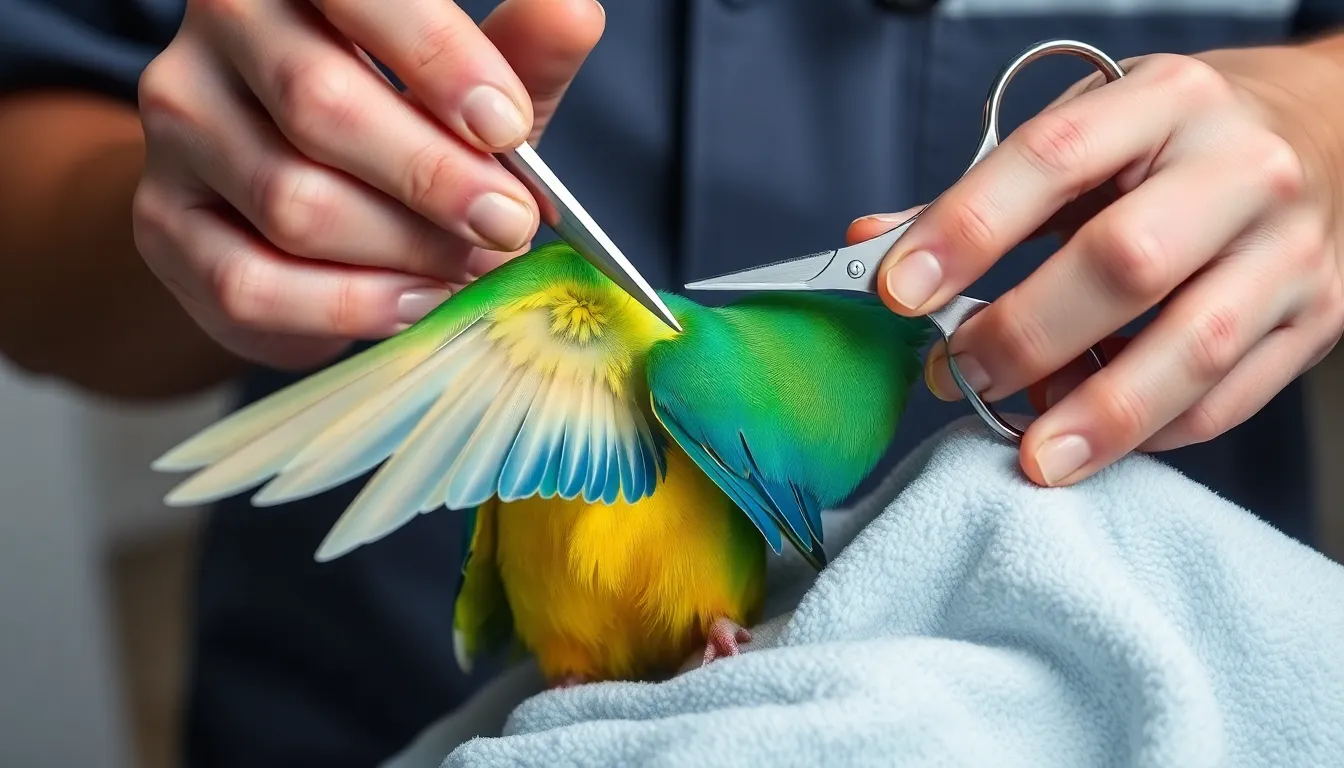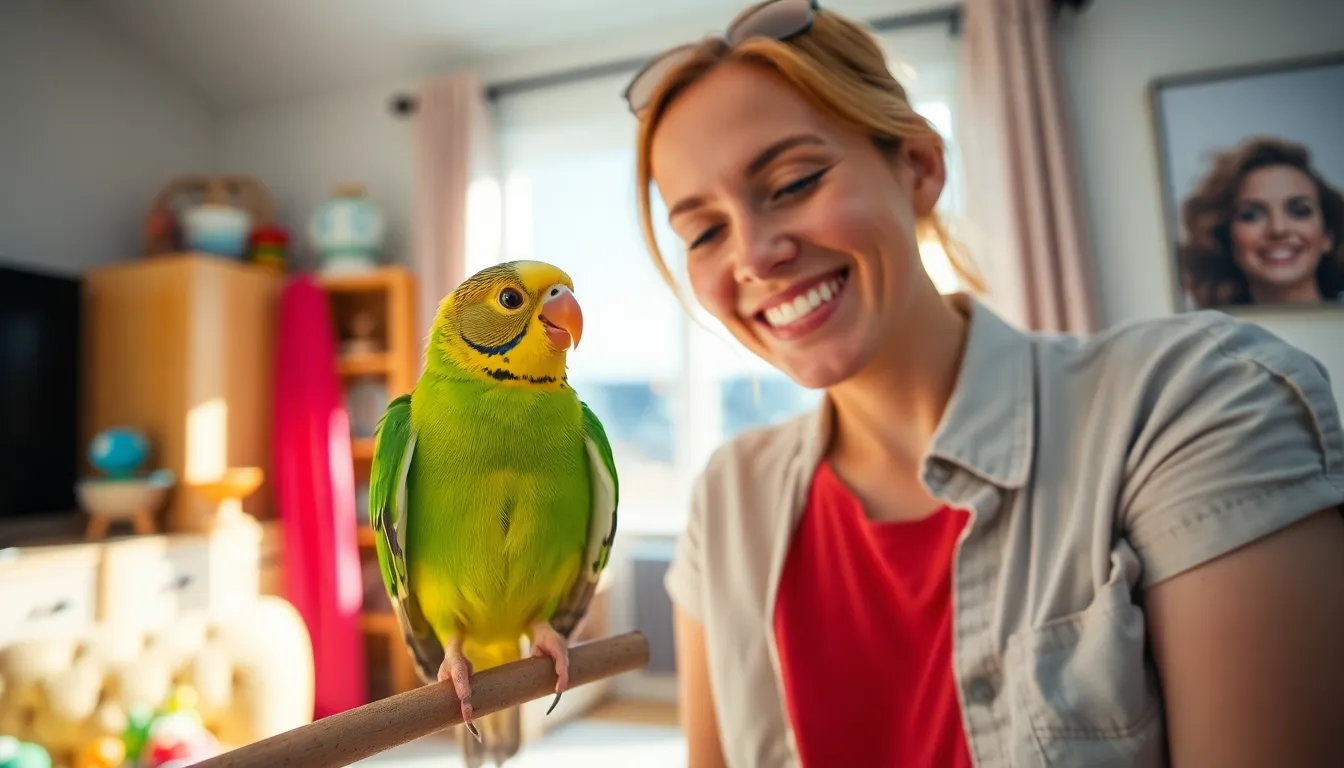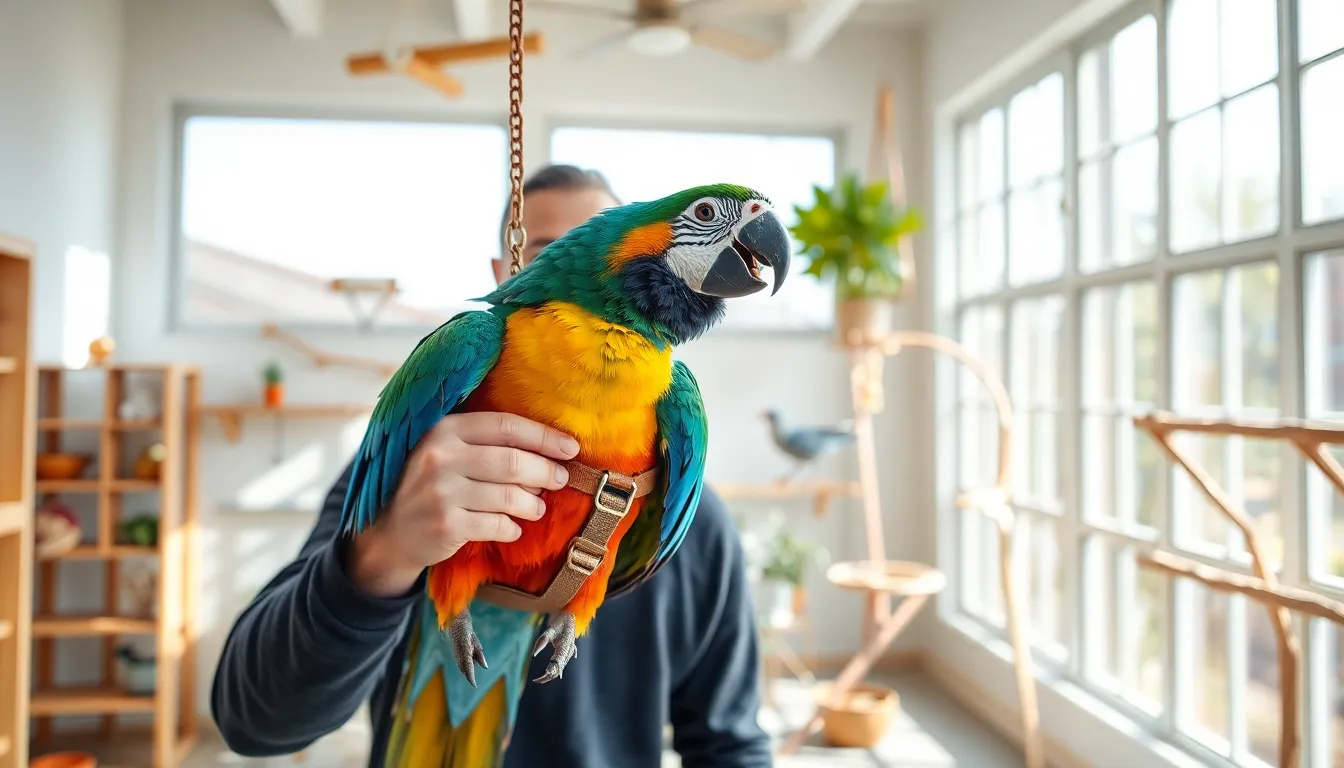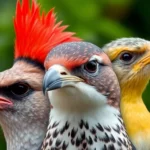We’ve all wondered whether clipping our feathered friend’s wings is the right choice. This common practice among bird owners sparks heated debates in aviaries and living rooms worldwide. While some swear by wing clipping for safety reasons others argue it’s cruel and unnecessary.
The truth is wing clipping isn’t as straightforward as many pet stores make it seem. There’s a delicate balance between keeping your bird safe and preserving their natural ability to fly. Poor clipping techniques can lead to serious injuries while proper methods might actually protect your beloved companion from household dangers.
Understanding the ins and outs of wing clipping empowers us to make informed decisions for our birds. Whether you’re a new bird owner or considering alternatives to traditional clipping methods we’ll explore everything you need to know about this controversial topic. Your bird’s wellbeing depends on getting this right.
What Are Clipped Bird Wings
Clipped bird wings refer to the practice of trimming a bird’s primary flight feathers to limit their ability to achieve sustained flight. We define this procedure as a temporary modification that reduces lift and prevents birds from gaining important altitude or distance during flight attempts.
The process involves cutting exact feathers on one or both wings, typically targeting the first 5-10 primary flight feathers. Professional avian veterinarians or experienced bird handlers perform this procedure by carefully trimming the feathers above the coverts while avoiding the blood-rich feather shafts called quills.
Bird wing clipping creates an asymmetrical or symmetrical flight pattern depending on the technique used. Single-wing clipping affects one wing only, causing the bird to fly in circles when attempting flight. Bilateral clipping involves trimming both wings equally, allowing controlled gliding with limited lift capacity.
The modification doesn’t cause physical pain to birds since feathers lack nerve endings in their outer portions. Birds experience temporary flight restriction similar to how humans might feel after removing a cast – they retain muscle memory for flight but lack the necessary equipment for full aerial mobility.
Clipped wings grow back during the bird’s natural molting cycle, which occurs annually or biannually depending on the species. Flight feathers regenerate completely within 6-12 months for most companion birds like cockatiels, parrots, and canaries.
Different clipping methods produce varying flight limitations:
- Light clip: Removes 3-5 primary feathers, allowing short flights and soft landings
- Standard clip: Trims 5-8 feathers, permitting controlled gliding to the floor
- Heavy clip: Cuts 8-10 primaries, restricting flight to brief downward movements
- Show clip: Maintains aesthetic appearance while providing minimal flight reduction
We recognize that clipped bird wings represent a management tool rather than a permanent alteration, giving owners temporary control over their bird’s mobility while maintaining the option for future flight restoration.
Reasons for Wing Clipping

Bird owners choose wing clipping for three primary reasons that focus on their pet’s wellbeing and household safety. Each motivation reflects exact concerns about bird behavior and environmental hazards.
Safety Concerns
Household dangers pose important risks to free-flying birds in domestic environments. Ceiling fans cause fatal injuries when birds fly into rotating blades during normal operation. Kitchen hazards include hot stoves, open pots with boiling water, and toxic fumes from overheated non-stick cookware that can kill birds within minutes.
Glass windows and mirrors create collision risks as birds cannot distinguish transparent or reflective surfaces from open flight paths. Other pets such as cats and dogs trigger their natural hunting instincts when birds fly freely throughout the home. Toxic plants like avocado, chocolate, and certain houseplants become accessible when birds explore unrestricted areas.
Electrical cords and outlets present electrocution hazards when curious birds chew on wires. Open doors and windows create escape opportunities that expose birds to outdoor predators, temperature extremes, and unfamiliar environments where survival rates drop significantly.
Training and Bonding
Clipped wings help closer relationships between birds and their owners through increased interaction opportunities. Birds with limited flight ability remain within proximity during training sessions, allowing for consistent positive reinforcement and skill development.
Step-up training becomes more manageable when birds cannot simply fly away from their owner’s hand or training perch. Recall training progresses faster as birds learn to walk or hop to their owners rather than relying on flight for transportation.
Socialization improves when birds spend more time at human eye level, participating in family activities and developing stronger bonds with household members. Speech training advances more rapidly as clipped birds engage in closer vocal interactions with their owners throughout the day.
Target training and trick learning accelerate when birds focus on ground-based activities rather than aerial exploration. Trust building occurs naturally as birds depend more on their owners for transportation and elevation changes within their environment.
Preventing Escape
Wing clipping eliminates the risk of birds flying out through open doors, windows, or during routine home maintenance activities. Outdoor escapes result in 85% mortality rates within the first week as domestic birds lack survival skills for wild environments.
Recovery efforts for escaped birds prove costly and often unsuccessful, with professional bird recovery services charging $200-500 per attempt. Weather conditions such as rain, wind, or temperature drops create additional survival challenges for birds unaccustomed to outdoor elements.
Predator threats increase dramatically outdoors, with hawks, cats, and other wildlife viewing escaped pet birds as easy prey. Lost birds face starvation as they cannot identify safe food sources or water locations in unfamiliar territory.
Veterinary costs escalate when escaped birds return injured from attacks, exposure, or malnutrition, often requiring emergency treatment ranging from $300-1,500. Prevention through wing clipping eliminates these emergency scenarios while maintaining the bird’s overall health and security within the home environment.
The Wing Clipping Process

The wing clipping process requires precision and expertise to ensure bird safety while achieving the desired flight limitation. Understanding proper techniques and choosing qualified professionals makes the difference between successful wing clipping and potential injury.
Professional vs. DIY Clipping
Professional avian veterinarians possess the anatomical knowledge and experience necessary for safe wing clipping procedures. These specialists understand bird wing structure, blood feather identification, and species-exact clipping patterns that minimize stress and injury risk. Veterinary professionals use proper restraint techniques that prevent bird trauma during the procedure.
DIY wing clipping presents important risks for inexperienced bird owners. Cutting blood feathers can cause severe bleeding and pain, while improper restraint techniques may result in fractures or psychological trauma. Many bird owners lack the knowledge to identify which feathers to cut and how many to remove for optimal results.
Emergency veterinary visits often result from DIY clipping accidents, with costs ranging from $200 to $800 for treating injuries. Professional clipping services typically cost $15 to $40, making professional care both safer and more economical than potential emergency treatments.
Experienced bird breeders and certified avian technicians can perform wing clipping safely when they’ve received proper training. These individuals understand bird handling techniques and possess the necessary tools for clean, precise cuts.
Proper Technique and Tools
Sharp, clean scissors designed specifically for feather cutting create the cleanest cuts and reduce feather damage. Avian professionals use surgical scissors or specialized feather scissors that range from 4 to 6 inches in length for optimal control.
Proper restraint involves securing the bird in a towel wrap that immobilizes wings while allowing access to flight feathers. The restraint technique must prevent wing flapping without restricting breathing or causing circulation problems.
Primary flight feathers receive the cut, typically starting from the outermost feather and working inward. Most professionals remove 5 to 8 primary feathers per wing, depending on the bird’s size and desired flight limitation level.
Cutting location matters significantly for bird comfort and feather regrowth. The cut occurs approximately 1 inch from where the feather shaft emerges from the wing, avoiding the blood supply area near the base.
| Tool Type | Purpose | Professional Use |
|---|---|---|
| Surgical scissors | Primary feather cutting | Veterinarians |
| Towel restraint | Bird immobilization | All professionals |
| Styptic powder | Bleeding control | Emergency backup |
| Good lighting | Feather visibility | Accuracy enhancement |
Symmetrical clipping involves cutting the same number of feathers on both wings to maintain balance during limited flight. Asymmetrical clipping removes feathers from one wing only, creating an imbalanced flight pattern that grounds the bird more effectively.
Blood feather identification prevents dangerous cuts that cause bleeding and pain. These developing feathers appear darker at the base and contain visible blood supply, requiring complete avoidance during clipping procedures.
Pros and Cons of Wing Clipping

Wing clipping presents both advantages and disadvantages that bird owners must carefully weigh. Understanding these trade-offs helps us make informed decisions about our feathered companions’ wellbeing.
Benefits of Clipped Wings
Enhanced safety represents the primary advantage of wing clipping in domestic environments. Clipped birds avoid dangerous encounters with ceiling fans, open windows, hot stovetops, and toxic household items that cause fatal accidents in free-flying pets. Training becomes significantly easier when birds remain within close proximity to their owners, allowing for more consistent behavioral reinforcement and skill development sessions.
Bonding opportunities increase substantially as clipped birds spend more time interacting with family members rather than perching in high, unreachable locations. Escape prevention protects domestic birds from outdoor dangers including predators, weather extremes, and starvation, as captive-bred birds lack essential survival skills for wild environments.
Veterinary visits become less stressful when birds can’t fly around examination rooms or hide in inaccessible areas. Exercise control allows owners to manage their birds’ activity levels while still permitting ground movement and short, controlled flights depending on the clipping method used.
Drawbacks and Risks
Physical injury risks increase when inexperienced individuals perform wing clipping procedures. Cutting blood feathers causes pain and bleeding, while improper technique can damage wing bones or create uneven flight patterns that lead to crash landings. Psychological stress affects some birds who experience anxiety or depression when their natural flight abilities become limited.
Behavioral changes may include increased aggression, excessive vocalization, or feather plucking as birds adapt to restricted mobility. Exercise reduction occurs as clipped birds rely less on wing muscles, potentially leading to weight gain and decreased cardiovascular health over time.
Social dynamics shift within multi-bird households when only some birds receive wing clips, creating potential conflicts or isolation among flock members. Emergency situations become more dangerous for clipped birds who cannot quickly escape threats like house fires, aggressive pets, or falling objects.
Dependency on owners increases as clipped birds require assistance reaching food, water, or safe perching areas that they previously accessed independently through flight.
Alternatives to Wing Clipping

Flight training offers one of the most effective alternatives to wing clipping for bird owners seeking safe management options. Recall training teaches birds to return on command using positive reinforcement techniques like treats and verbal praise. Station training involves teaching birds to fly to exact perches or designated areas within the home. Target training uses a stick or pointer to guide birds to safe locations while maintaining their natural flight abilities.
Environmental modifications create safer spaces for free-flying birds without restricting their mobility. Installing ceiling fan guards prevents dangerous encounters with rotating blades. Covering mirrors and windows with decals or screens eliminates collision risks during flight. Removing toxic plants from bird-accessible areas protects against accidental poisoning. Creating bird-safe rooms with closed doors provides secure flying spaces for exercise and enrichment.
Harness training allows birds to experience outdoor environments while maintaining owner control. Flight suits and harnesses come in various sizes designed for different species from cockatiels to macaws. Training birds to wear harnesses requires patience and gradual introduction over several weeks. Supervised outdoor time with proper harnesses provides mental stimulation and vitamin D exposure without clipping wings.
Supervised free flight in controlled environments offers another wing clipping alternative. Bird-proofed rooms eliminate potential hazards while allowing natural flight behavior. Enclosed aviaries provide spacious flying areas with protection from predators and weather. Indoor flight cages measuring at least 6 feet in length give medium-sized birds adequate exercise space.
Flight suits serve as temporary mobility control without permanent feather modification. These fabric garments wrap around the bird’s body and wings to prevent flight while allowing normal movement. Flight suits work best for short-term situations like veterinary visits or travel. Proper fitting prevents chafing and ensures the bird’s comfort during wear.
Positive reinforcement training builds strong recall behaviors without physical restrictions. Teaching “step up” and “step down” commands creates reliable handling methods. Establishing regular routines helps birds understand boundaries and expectations. Consistent training sessions lasting 10-15 minutes develop trust and cooperation between birds and owners.
Indoor aviaries provide the ultimate wing clipping alternative for dedicated bird owners. Custom-built flight cages measuring 10x6x8 feet accommodate multiple birds safely. Walk-in aviaries allow owners to interact with birds in their flying space. Professional aviary construction ensures proper ventilation and safety features for long-term use.
Caring for Birds with Clipped Wings

Birds with clipped wings require specialized care to maintain their physical health and psychological wellbeing. We must adapt our care routines to accommodate their limited flight capabilities while ensuring they remain active and engaged.
Exercise and Activity Needs
Clipped birds develop alternative exercise patterns to compensate for their restricted flight abilities. Walking and climbing become primary forms of physical activity, requiring us to provide multiple perches at varying heights throughout their environment. Ladder climbing exercises strengthen leg muscles and maintain coordination, with studies showing that flightless birds increase ground movement by 67% compared to their flying counterparts.
Foraging activities stimulate natural behaviors while providing essential physical movement. We encourage wing flapping exercises by placing food sources at elevated locations that require stretching and reaching motions. These activities maintain muscle tone in flight muscles even when full flight isn’t possible.
Mental stimulation becomes crucial for clipped birds since they can’t engage in complex aerial maneuvers. Puzzle feeders and interactive toys provide cognitive challenges that prevent boredom related behavioral issues. Research indicates that clipped birds require 40% more environmental enrichment to maintain equivalent stress hormone levels compared to free flying birds.
Social interaction opportunities multiply in importance for wing clipped birds since they spend more time at ground level with their human companions. Daily out of cage time on play stands allows for supervised exploration while building trust between bird and owner. We establish structured activity schedules that include 3 to 4 hours of active engagement outside the cage environment.
Regrowth and Maintenance
Wing feather regrowth follows predictable patterns during the bird’s natural molting cycle. Most songbirds and parrots molt primary flight feathers over 6 to 8 month periods, with complete regrowth occurring within 12 to 18 months depending on species size and age. We monitor feather development weekly to assess progress and plan for transitional care needs.
Nutritional support during regrowth phases becomes essential for proper feather development. High protein diets containing 18% to 22% protein content support keratin production in developing feathers. Vitamin A supplementation at 8000 to 10000 IU per kilogram of body weight promotes healthy feather structure and prevents developmental abnormalities.
Trimming schedules require adjustment based on individual regrowth rates and household safety considerations. We evaluate flight capability monthly once new feathers emerge, as partial regrowth can create unpredictable flight patterns that increase accident risks. Some birds require maintenance trims every 4 to 6 months while others benefit from complete regrowth before reassessment.
Blood feather monitoring during regrowth prevents injury from premature trimming of developing feathers. These growing feathers contain active blood supplies and cause important bleeding if damaged. We identify blood feathers by their darker, waxy appearance and avoid any handling until they fully mature and the blood supply recedes.
Environmental safety assessments accompany each stage of wing regrowth to prevent accidents during transitional flight periods. Birds with partially regrown wings often attempt flights beyond their current capabilities, leading to crash landings and potential injuries. We remove or cushion hard surfaces near favorite perching areas and maintain constant supervision during out of cage activities.
Conclusion
We’ve explored the complexities surrounding wing clipping and its impact on our feathered companions. This practice remains deeply personal and requires careful consideration of each bird’s unique circumstances and our individual living situations.
The decision eventually rests on balancing safety concerns with our bird’s natural behaviors and psychological needs. Whether we choose clipping professional alternatives or environmental modifications we must prioritize our pet’s overall wellbeing above all else.
Remember that there’s no one-size-fits-all solution. What works for one bird and household may not suit another. We encourage consulting with avian veterinarians and considering all available options before making this important choice for our beloved birds.
Frequently Asked Questions
What is wing clipping in birds?
Wing clipping is the trimming of a bird’s primary flight feathers to limit their ability to achieve sustained flight. This procedure involves cutting specific feathers to create either symmetrical or asymmetrical flight patterns. It’s typically performed by professional avian veterinarians or experienced handlers and doesn’t cause physical pain since feathers lack nerve endings.
Why do bird owners choose to clip their bird’s wings?
Bird owners clip wings for three main reasons: safety concerns, training and bonding, and preventing escape. Wing clipping protects birds from household dangers like ceiling fans and toxic plants, enhances training by keeping birds closer to owners, and prevents potentially fatal escapes where domestic birds lack survival skills in the wild.
Does wing clipping hurt birds?
No, wing clipping doesn’t cause physical pain because feathers lack nerve endings. However, improper clipping can cause injury if blood feathers are cut or if the procedure is done incorrectly. The process is painless when performed properly by experienced professionals, though some birds may experience temporary stress during handling.
Do clipped wings grow back?
Yes, clipped wings grow back during the bird’s natural molting cycle. Feathers are living structures that regenerate over time, typically within 6-12 months depending on the species and individual bird. This makes wing clipping a temporary management tool rather than a permanent modification to the bird’s anatomy.
Should I clip my bird’s wings myself?
No, DIY wing clipping is not recommended for inexperienced owners. Professional clipping by avian veterinarians ensures safety and proper technique. Improper clipping can cause severe injury, painful cuts to blood feathers, and costly emergency veterinary visits. Professional services are safer and more economical than attempting it yourself.
What are the alternatives to wing clipping?
Alternatives include flight training (recall, station, and target training), environmental modifications like ceiling fan guards, harness training for outdoor exploration, supervised free flight in bird-proofed spaces, flight suits for temporary mobility control, and indoor aviaries. These options maintain natural flight abilities while ensuring safety.
How do I care for a bird with clipped wings?
Birds with clipped wings need adapted exercise routines including walking and climbing, mental stimulation through interactive toys, high-protein diets during feather regrowth, regular monitoring of feather development, and enhanced environmental safety measures. Maintaining physical health and psychological wellbeing requires specialized attention during the clipped period.
What are the pros and cons of wing clipping?
Pros include enhanced safety from household dangers, easier training and bonding opportunities, and reduced stress during veterinary visits. Cons include risk of physical injury from improper clipping, potential psychological stress, changes in social dynamics in multi-bird households, and temporary loss of natural flight abilities.







